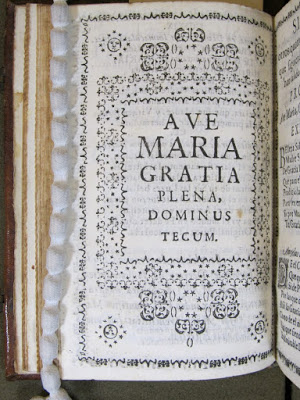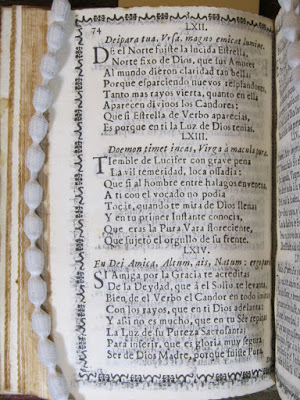As a nod to the Pope-adelphia trend now sweeping the city and to the wonderful Sacred Stories exhibit put up by our colleagues in the Free Library’s Rare Books Department, this week we opened our new exhibition Catholics in the New World. Among the dozen items in the show are some of the earliest books printed in the Americas as well as religious texts in a panoply of Native American languages, but I think one of the most unusual books is a small Mexican book from 1731: Anagrammas en aplauso, y gloria de la concepcion purissima de Maria.
As the title suggests, this book is a book of anagrams in honor of the Immaculate Conception of the Virgin Mary. More specifically, it contains over 2500 anagrams of the angel’s greeting to Mary from Luke 1:28:”Ave Maria, gratia plena, Dominus tecum” (Hail Mary, full of grace, the Lord is with thee.”
When Elizabeth Fuller, our librarian, first mentioned this book to me, I was very intrigued–it seemed like such a fascinating, and somewhat strange, idea. As I started to do some research, I discovered that the concept was by no means unique. In fact, the author, Juan Antonio de Mora, only composed about a third of the anagrams in his book; he copied the others from earlier sources.
It seems like the interest in Marian anagrams starts in the mid-17th century with Joannes-Baptista Agnensis (to give the Latin form of his name). Walter Begley’s Biblia Anagramatica explains,”This blind dependent of Cardinal Julius Rospigliosus may justly be termed the Father of Biblical Anagrams, for it was his printed broadsheet of a hundred anagrams on the angelic salutation that first brought them into fashion.” This first printed broadsheet appeared in 1661. Subsequent works by Agnensis brought his anagram total to 1115.
Later authors such Ambrosius Niesporkowitz and Lucas De Vries take the cake for the sheer number of anagrams they produced: Niesporkowitz’s 1701 Fragmenta contains 3000 metrical anagrams and De Vries’s Metamorphosis Angelica from 1711 contains 3100 prose examples. However, what the Mexican book has that the others do not, is that Juan Antonio de Mora also composed over 500 eight-line Spanish poems to expand on the anagrams.
So what’s the deal with the anagrams? All of these anagrams of the Angelic Salutation were intended to promote the doctrine of Mary’s Immaculate Conception (which would finally become official Catholic dogma in 1854). The anagrams functioned in several ways. At the most basic level, the text of the anagrams themselves promoted the doctrine.
But there was also a deeper way in which the anagrams were seen as supporting the doctrine: the very fact that the angel’s message could be rearranged so prolifically into so many texts praising the Virgin was seen as proof of their truth. Of course, with a text of this length mathematical probability alone would suggest that there would be numerous anagrams, but the authors of these books were more religiously than statistically minded and the existence of such anagrams was seen as a profound matter.
So come by the Rosenbach to see Anagrammas en aplauso in person, Did I mention that it is free to come in and see Catholics in the New World (you still have to pay to see our other exhibitions or to tour the house). I also encourage you to play around with making your own anagrams; if you’re lazy, there are even online sites that will do them for you (the one I linked to even does Latin, so you can try to replicate de Mora’s work).
This is A Shaky Hat (aka Kathy Haas) signing off.



